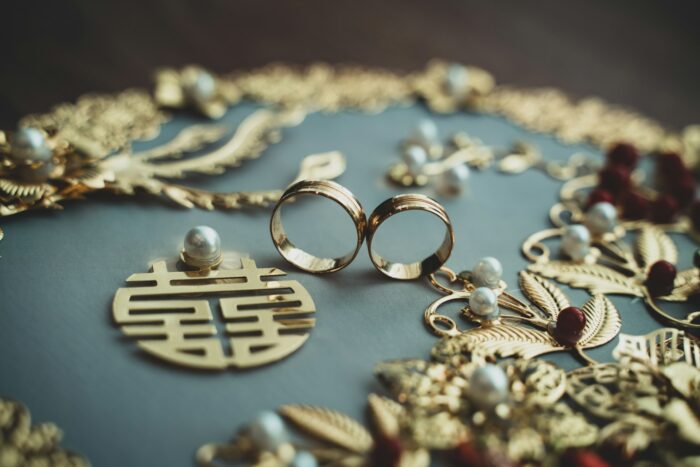Gold Identification Marks on Jewelry

When it comes to precious metals, understanding the value of your jewelry is essential when determining if the pieces that have adorned your collection for years should be held or sold. At Express Gold Cash, we recognize that our audience is keen on doing their due diligence in identifying the worth of their treasures. Our goal is to help make that process as easy as possible while ensuring you experience the maximum return on your efforts when it’s all said and done.
In this article, we’ll guide you through the essential knowledge of gold identification marks on jewelry, which is a niche but altogether valuable skill for anyone looking to evaluate their gold items accurately. You can click the links below to skip to any of the sections in this article or keep reading to get the full scoop:
- Section 1: What Are Gold Identification Marks?
- Section 2: Understanding Gold Purity Marks (Aka Fineness Marks)
- Section 3: 5 Common Shades of Gold
Whether inherited, gifted, or acquired through personal investments, gold and jewelry range in holding sentimental value and significant monetary potential. The key to unlocking this potential lies in the small, often overlooked details: gold identification marks.
Gold identification marks hold the secrets to your gold items’ purity, origin, and history, which is crucial in determining their value. With a focus on selling your valuables, understanding these marks becomes not just a matter of curiosity but a financial imperative.
What Are Gold Identification Marks?
Gold identification marks are essentially the fingerprints of fine jewelry, offering clues about its purity, maker, and origin. Up to four marks may be present on your gold, which can be astounding given the nature of pieces that are often physically small.
Types of Gold Marks
Purity Marks (aka Fineness Marks)
Indicate the gold content in the alloy, telling you how much of the metal is pure gold. The term “fineness” is explicitly used to indicate the purity of a precious metal in parts per thousand—more on that in the next section.
Maker’s Marks
Identify the company or artisan who manufactured the jewelry.
Date Letters
Sometimes included to mark the year the item was made.
Town Marks
Signify the city or country where the jewelry was crafted.
These marks are typically found on the clasp of a necklace, the inner band of a ring, or the back of a pendant and require a keen eye or a magnifying glass to decipher. Again, it’s a lot of information to pack on a small piece.
Understanding Gold Purity Marks (Aka Fineness Marks)
Purity marks on jewelry specify the gold content regarding karats or fineness. Here’s a breakdown of common fineness marks. The numbers at the front signify the rate on a scale of parts per thousand gold to other metals.
375 Gold Stamp (9 Karat)
37.5% pure gold. It’s durable due to the higher percentage of other metals.
585 Gold Stamp (14 Karat)
58.5% pure gold. This mark balances purity with practicality, offering good resistance to wear.
750 Gold Stamp (18 Karat)
75% pure gold, denoting a high purity level and a rich yellow color.
916 Gold Stamp (22 Karat)
91.6% gold. It’s pretty soft and is usually used in more traditional jewelry from older cultures and heritages.
999 Gold Stamp (24 Karat)
Represents pure gold, with minimal to no other metals mixed in. It’s the softest form of gold and is rarely used in everyday jewelry due to its delicacy.
5 Common Shades of Gold
Gold’s versatility is not limited to its purity but extends to its color, achieved by mixing it with various alloys. Here are five common shades of gold:
White Gold
White gold is created by alloying gold with white metals like palladium or silver, often coated with rhodium for added durability and shine.
Yellow Gold
Yellow gold is the classic gold color, achieved by mixing pure gold with silver, copper, and zinc.
Rose Gold
Rose gold is this pinkish hue that comes from a higher copper content in the alloy.
Green Gold (Electrum)
Green gold is made by using a natural alloy of gold and silver, giving it a subtle green tint.
Grey Gold (Palladium)
Alloyed with palladium, grey gold variant has a greyish tone and is stronger than pure gold.
What Is Your Gold Worth?
Deciphering the marks on your jewelry unveils the story behind each piece and its intrinsic value. At Express Gold Cash, we understand the importance of trust and transparency in this process. Our expert appraisers are equipped to evaluate your jewelry’s worth accurately, guided by the purity, craftsmanship, and rarity these essential marks indicate.
Whether you want to sell or simply appraise your gold, Express Gold Cash offers a secure, efficient, and rewarding online platform to meet your needs. Embrace the opportunity to transform your jewelry into financial assets with confidence and sophistication.
Get started with a free appraisal kit. This can be a great first step to starting the evaluation process from the comfort of your home.




